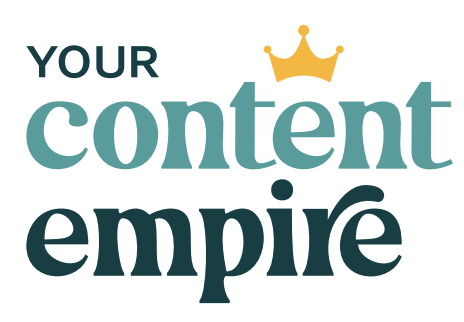How do you create a competitive content analysis that actually helps your business succeed? This post teaches you how to perform a competitive content analysis so that you can find opportunities to make your content stand out.
I work with a long-term retainer client who came to me because she was struggling to sell any of the courses and mini-courses that she’d lovingly and painstakingly put together. And even though she was marketing her butt off and promoting these things in all the right ways, she felt like she was going in circles and making zero progress.
When we sat down to finally examine why this was happening, I started things off with a competitive content analysis, and through that, we discovered that most of her paid programs and many courses were being done by other people: but for free. Even the names were similar. And we learned that she was marketing these in the same places, with the same language, and to the same people.
So while I'm all about ‘community over competition’ by embracing and cheering on other businesses in my space, I'm also not about putting your head in the sand.
If we hadn't intervened by looking at the competition with my client, how long would’ve she kept doing things the same way? How long before she’d decide to shelve her gifts permanently?
So in this post, I'm going to walk you through a process of really getting to know what your quote-unquote competitors are up to, gain a high-level view of your industry landscape, and summarize your takeaways into actionable ideas to implement into your content strategies.
Prefer to watch this blog post instead? Click on the video below!
What is a Competitive Content Analysis?
A competitive content analysis is an individualized examination of what content your competitors are creating, where they’re marketing their businesses, the language they’re using, the offers they’re making, and the results they’re getting.
The purpose is to help you survey the landscape so you can find a spot where you fit best. It also helps you gain insight on what strategies to cut or double-down on to increase your unique advantage.
REMEMBER → The point of this exercise isn’t to make you feel bad or measure yourself against them. We’re doing this so you can create better content for your audience. And see better results in your business at the end of the day.
Competitive Content Analysis: Step 1 – Create a List of Your Competitors
Start by looking for businesses that are selling the same (or similar) offers as you do, creating content around the same topics and categories. Look for people who are further along and at the same stage as you in business.
If you’re a location-based business, search locally but also further too as you can learn a lot from what others are doing in other areas too!
At this stage, we’re just creating an unfiltered list so collect as many as you can.
Source #1 → Write down anyone who immediately comes to mind (I’m sure there are some you can think of right away)
Source #2 → Search on Facebook for your title (i.e. wedding photographer, digital marketer, copywriter)
Source #3 → Search on Google for your title (i.e. wedding photographer, digital marketer, copywriter)
Source #4 → Search on Pinterest for your industry/niche and your product/offer (i.e. wedding photography and wedding photos, copywriting and website/email/marketing copy)
Source #5 → Search in Facebook groups for your title, industry/niche and product/offer (i.e. wedding photographer + wedding photography + wedding photos)
Once you have your big list, narrow it down to between 5-10 who you felt were the closest to what you do and create content around.
Competitive Content Analysis: Step 2 – Complete a Platform Analysis
Next, we’re going to collect any content information we can gather from their website and social media profiles. Go through this process for everyone who you’ve added to your shortlist.
On their website and blog:
- From the homepage: what’s the tagline, who do they work with, what do they call themselves (title wise)?
- From their offer pages: what are their offers, price points, what’s included in those offers, and what words do their past clients/customers use to describe the results they’ve gotten?
- From their blog: what categories do they write about, what were the titles of their last 5-7 blog posts, how much engagement is visible on these blog posts?
- Freebies: what free offers are they using to build their email list (names, what’s included and format)?
- Are there any media or collaboration logos visible? Add these to the featured section.
Social media profiles (top 3):
- What platform are they using? Followers?
- How often are they posting and using it?
- What type of content are they posting?
- What levels of engagement are their posts receiving?
Media and collaborations:
- In Google, search for their name and business name to see if they’ve been featured on other websites.
- In Google, search for interviews – Interview + “NAME” (try their business name too).
- In Google, search for guest posts – Guest + “Name” (try their business name too).
- In iTunes, search for podcast interviews by searching for their name and business name.
- Where have they been featured? What are the topics of those features?
Competitive Content Analysis: Step 3 – Summarize the Information
You’ve created a list of your competitors, and you’ve completed a platform analysis. Now we’re going to use the information we’ve gleaned to define your approach in each of these areas. Here’s how you do it:
Website
- What are most people calling themselves? → What’s your title?
- What are most of the taglines like? → What’s your unique tagline?
Offers
- What are they offering? → What are your unique offers?
- What are they including in their offers? → What is your unique spin?
- What are they pricing their offers around? → What is your pricing?
Content
- What categories are they using? → Are the categories similar to yours?
- What topic ideas did you come up with from looking at others? → What new topics could you cover?
- What formats are they using? → What’s your format?
Freebies
- What freebies are they using? → What are your freebies?
- What formats are they using? → What format are your freebies in?
- What problems are they solving? → What problem does your freebie solve?
Social
- What channels are they using? → What social channels are you using?
- What type of content are they posting? → What’s your content type?
- What engagement are they getting? → What is your engagement like?
Media and Collaborations
- Where have they been featured? → Where have you been featured?
- What types of businesses have they collaborated with? → What businesses have you collaborated with?
Takeaways
Once you've completed your competitive content analysis, I hope that in addition to seeing opportunities to take your own content to the next level, that you also see how well you're already doing.
All of us can benefit from a little insight but often don't know where to find it. What you’ve just done is create your own panel of industry experts. Now you just have to make the most of their insights!













